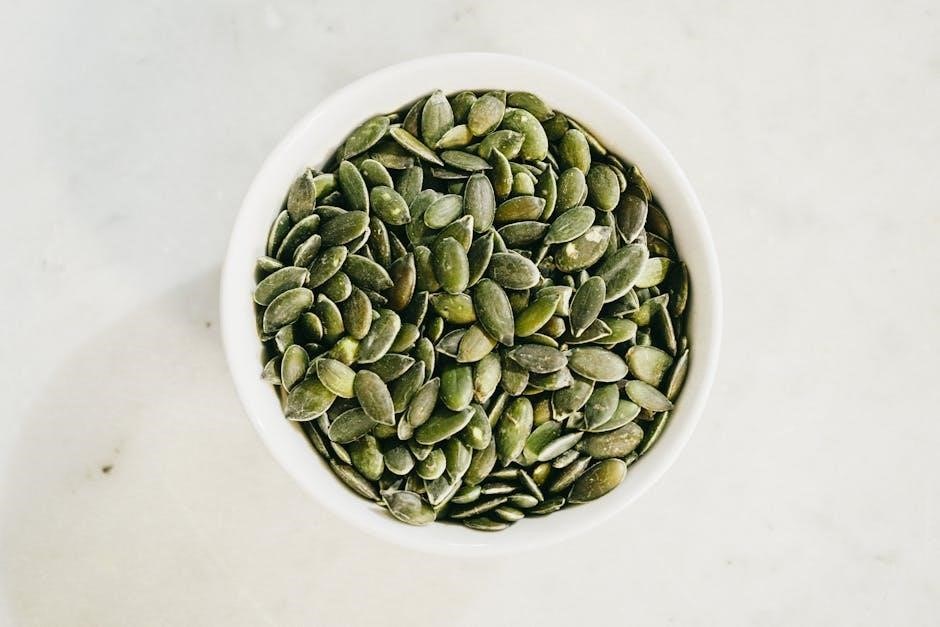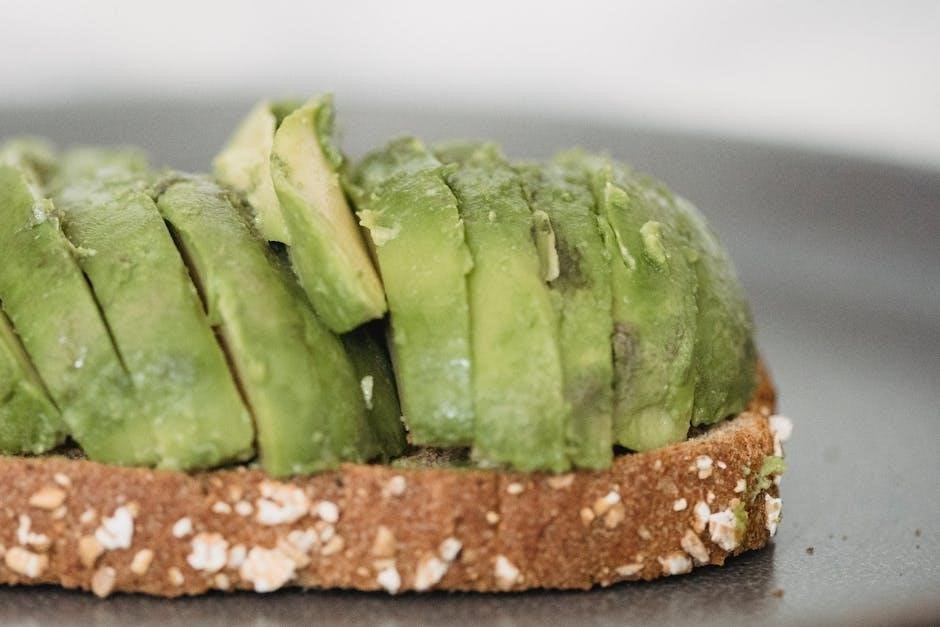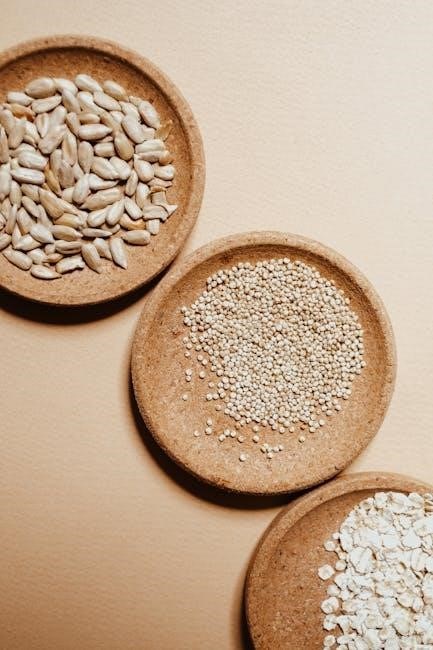A low-fat diet focuses on reducing fat intake to promote weight management and heart health. It emphasizes whole‚ nutrient-rich foods like fruits‚ vegetables‚ and lean proteins‚ helping to create a balanced and sustainable eating plan.
Understanding the Importance of a Low-Fat Diet
A low-fat diet is essential for reducing the risk of heart disease‚ managing weight‚ and improving overall health. By limiting saturated and trans fats‚ it helps lower cholesterol levels and prevent cardiovascular issues. This dietary approach supports long-term wellness‚ particularly for individuals with conditions like high cholesterol or gallbladder concerns. It also aids in maintaining a healthy weight‚ which further reduces the risk of chronic diseases. Understanding the benefits of a low-fat diet is crucial for making informed‚ sustainable lifestyle choices.
Benefits of a Low-Fat Diet for Weight Management and Heart Health
A low-fat diet significantly supports weight management by reducing calorie intake and promoting a healthier metabolic balance. It also plays a crucial role in improving heart health by lowering cholesterol levels and reducing blood pressure. By limiting saturated and trans fats‚ this diet helps prevent plaque buildup in arteries‚ minimizing the risk of heart disease. Additionally‚ it aids in managing conditions like hypertension and high cholesterol‚ contributing to overall cardiovascular well-being. Incorporating a low-fat diet can lead to long-term health benefits and a reduced risk of chronic diseases.

Food Groups in a Low-Fat Diet
A low-fat diet emphasizes whole‚ nutrient-dense foods‚ focusing on fruits‚ vegetables‚ lean proteins‚ whole grains‚ and low-fat dairy. These groups provide essential vitamins‚ minerals‚ and fiber while minimizing fat intake.
Fruits: Focus on Apples‚ Pears‚ Oranges‚ and Berries
Fruits like apples‚ pears‚ oranges‚ and berries are excellent choices for a low-fat diet. They are naturally low in fat‚ rich in fiber‚ and packed with antioxidants. Apples and pears provide satisfying crunch‚ while oranges offer vitamin C and hydration. Berries‚ such as blueberries and strawberries‚ are high in antioxidants and low in calories. Incorporating these fruits into meals and snacks supports weight management and heart health. Their versatility makes them ideal for smoothies‚ salads‚ or as standalone snacks.
- Apples: High in fiber and antioxidants.
- Pears: Gentle on digestion and rich in vitamins.
- Oranges: Excellent source of vitamin C.
- Berries: Packed with antioxidants and low in calories.
Vegetables: Low-Fat and Nutrient-Rich Options
Vegetables are a cornerstone of a low-fat diet‚ offering minimal fat while providing essential vitamins‚ minerals‚ and fiber. Leafy greens like spinach‚ broccoli‚ and kale are rich in nutrients and low in calories. Other options include cucumbers‚ bell peppers‚ and carrots‚ which are versatile for salads‚ snacks‚ and cooking. These vegetables support heart health and digestion‚ making them a healthy addition to any meal. Incorporating a variety ensures a balanced intake of nutrients without excess fat.
- Leafy greens: Spinach‚ kale‚ broccoli.
- Cruciferous vegetables: Cabbage‚ cauliflower.
- Colorful options: Bell peppers‚ carrots‚ tomatoes.
Proteins: Lean Meats‚ Fish‚ Eggs‚ and Tofu
Lean proteins are essential for muscle maintenance and satiety in a low-fat diet. Opt for poultry like chicken and turkey‚ selecting skinless cuts to reduce fat. Fish‚ such as cod and salmon‚ provides omega-3 fatty acids without excess saturated fat. Eggs are a versatile‚ low-fat protein source‚ while tofu offers a plant-based alternative. These options support heart health and weight management‚ making them ideal for balanced meals. Choose these proteins to meet dietary needs without excessive fat intake.
- Poultry: Skinless chicken‚ turkey.
- Fish: Cod‚ salmon‚ tilapia.
- Eggs and egg whites.
- Plant-based: Tofu‚ tempeh.
Dairy: Choosing Skim Milk‚ Low-Fat Cheese‚ and Nonfat Yogurt
Dairy products are a great source of calcium and vitamins but can be high in fat. Opt for skim milk‚ low-fat cheese‚ and nonfat yogurt to enjoy the benefits without excess fat. These options are rich in nutrients and support heart health. Avoid whole milk‚ cream‚ and high-fat cheeses like cheddar or brie. Low-fat dairy helps maintain a balanced diet while keeping fat intake in check. Incorporate these into meals for a healthier‚ more satisfying choice.
- Skim milk and low-fat yogurt.
- Low-fat cheese varieties (e.g.‚ part-skim mozzarella).
- Nonfat sour cream and cottage cheese.

Grains: Selecting Whole Grain Breads‚ Cereals‚ and Pasta
Whole grains are a cornerstone of a low-fat diet‚ offering fiber‚ vitamins‚ and minerals. Choose whole grain breads‚ cereals‚ and pasta for their nutrient-rich‚ low-fat profile. Avoid refined grains like white bread or processed cereals‚ which lack fiber and nutrients. Opt for brown rice‚ quinoa‚ oats‚ and barley for added variety. These grains support heart health and digestion while keeping fat intake low. Incorporate them into meals for a balanced and satisfying diet.
- Whole grain bread and cereals.
- Brown rice‚ quinoa‚ and barley;
- Oats and whole wheat pasta.

Grocery Shopping Tips
Plan your shopping list to focus on whole‚ nutrient-rich foods. Always read food labels to check fat content and avoid processed‚ high-fat snacks.
- Choose whole grains and lean proteins.
- Select low-fat dairy products.
- Limit fried and processed foods.
How to Read Food Labels for Fat Content
Reading food labels is essential for managing fat intake. Start by checking the Nutrition Facts panel for total fat‚ saturated fat‚ and trans fat per serving; Pay attention to serving sizes‚ as they can be smaller than you think. Look for products with less than 3g of fat per serving for low-fat options. Choose items with no trans fats and limit saturated fats to maintain heart health. Compare brands to find healthier alternatives‚ and avoid foods with hidden fats‚ such as processed snacks and fried items.
Avoiding High-Fat Foods: Fried Foods‚ Pastries‚ and Processed Snacks
Fried foods‚ pastries‚ and processed snacks are high in saturated and trans fats‚ which can increase health risks. Fried items like french fries and doughnuts are calorie-dense and should be limited. Pastries and baked goods often contain butter or lard‚ boosting fat content. Processed snacks‚ such as chips and cookies‚ are typically high in unhealthy fats. Opting for baked or grilled alternatives and choosing whole‚ unprocessed foods helps reduce fat intake and supports a healthier diet.

Meal Planning and Preparation
Effective meal planning involves creating balanced menus with lean proteins‚ whole grains‚ and fresh produce. Use cooking methods like grilling and baking to reduce fat.
Sample 7-Day Low-Fat Meal Plan
A well-structured 7-day meal plan helps maintain a balanced low-fat diet. Start with oats‚ fruit‚ and skim milk for breakfast. Include grilled chicken or fish with steamed vegetables for lunch and dinner. Incorporate legumes‚ whole grains‚ and salads throughout the week. Snacks like berries or yogurt keep energy levels steady. Avoid fried foods and opt for baking or grilling to reduce fat intake. Vary protein sources‚ including tofu and lean meats‚ and season with herbs for flavor. This plan ensures a nutritious and satisfying approach to low-fat eating.
Cooking Methods: Grilling‚ Poaching‚ and Baking
Grilling‚ poaching‚ and baking are excellent low-fat cooking methods that preserve flavor without added fats. Grilling allows fats to drip away‚ making meats leaner. Poaching gently cooks foods like fish or eggs in liquid‚ avoiding oil. Baking uses minimal fat‚ ideal for vegetables‚ proteins‚ and whole grains. These techniques enhance natural flavors using herbs and spices‚ ensuring meals are nutritious and satisfying. They are versatile and promote a healthier diet by reducing fat intake while maintaining moisture and taste in dishes like grilled vegetables or baked fish with lemon.

Health Considerations
A low-fat diet supports heart health and weight management‚ reducing risks of chronic diseases. It’s often recommended for conditions like gallstones‚ pancreatitis‚ and fatty liver disease. Consult a healthcare provider before starting.
Medical Conditions That May Require a Low-Fat Diet
Certain medical conditions benefit from a low-fat diet‚ such as gallstones‚ pancreatitis‚ and fatty liver disease. It reduces strain on the digestive system and helps manage symptoms. Individuals with heart disease or high cholesterol may also benefit. Additionally‚ post-gallbladder removal patients often follow this diet to avoid discomfort. Always consult a healthcare provider to determine if a low-fat diet is appropriate for specific health needs and to ensure proper nutrition.
Consulting a Registered Dietitian for Personalized Advice
A registered dietitian provides tailored guidance for a low-fat diet‚ ensuring it meets individual health needs. They create personalized meal plans and offer strategies to maintain nutrition while reducing fat intake. This expertise helps address specific medical conditions and promotes sustainable lifestyle changes‚ making the diet more effective and manageable for long-term health benefits.

Practical Tips for Reducing Fat Intake
Practical Tips for Reducing Fat Intake: Focus on fresh produce‚ lean proteins‚ and whole grains. Avoid fried foods and opt for low-fat dairy. Use herbs and spices for flavor instead of fats. Incorporate grilling and baking as healthier cooking methods.
Incorporating Fresh Produce and Legumes
Fresh produce and legumes are foundational to a low-fat diet‚ offering essential vitamins‚ minerals‚ and fiber. Focus on colorful fruits and vegetables to ensure a wide range of nutrients. Legumes‚ such as beans and lentils‚ provide plant-based protein and fiber‚ supporting heart health and digestion. Incorporate them into meals like soups‚ salads‚ and stir-fries. Snack on fresh fruits and raw vegetables to curb cravings without added fats. These choices not only reduce fat intake but also promote overall health and weight management.
Using Herbs and Spices for Flavor Instead of Fats
Herbs and spices are excellent alternatives to fats for adding flavor to meals. Basil‚ oregano‚ cumin‚ and turmeric can enhance dishes without extra calories. Try seasoning lean proteins or vegetables with garlic‚ paprika‚ or chili powder. Lemon juice or vinegar can also brighten flavors. This approach reduces reliance on oils‚ butter‚ or creamy sauces‚ making meals healthier and lower in fat. Experimenting with spices and herbs not only elevates taste but also supports weight management and heart health by keeping fat intake in check.
A low-fat diet promotes heart health and weight management through nutrient-rich‚ balanced choices. Embrace a sustainable lifestyle with flavorful‚ wholesome meals tailored to your needs and preferences.
Maintaining a Balanced and Satisfying Low-Fat Lifestyle
Maintaining a low-fat lifestyle is achievable by focusing on whole‚ nutrient-dense foods and mindful portion control. Incorporate a variety of fruits‚ vegetables‚ lean proteins‚ and whole grains to ensure satisfaction and nourishment. Plan meals in advance and use herbs and spices for flavor instead of fats. Staying hydrated and being consistent with healthy choices supports long-term success. Consulting a dietitian can also provide personalized strategies to keep your low-fat diet enjoyable and sustainable for years to come.